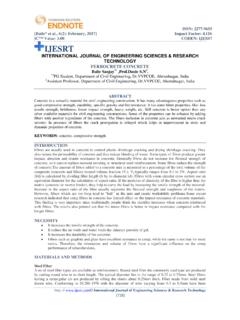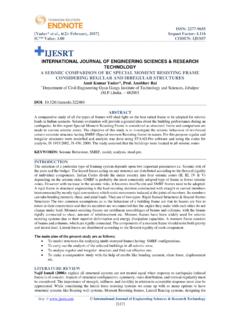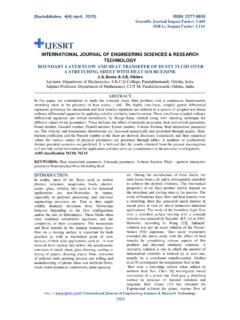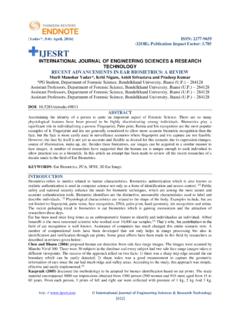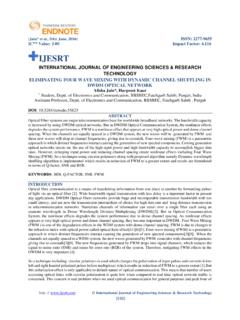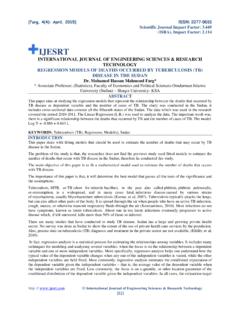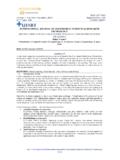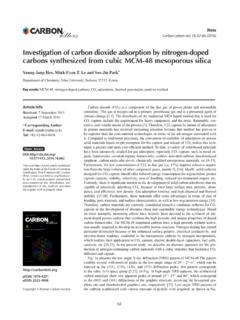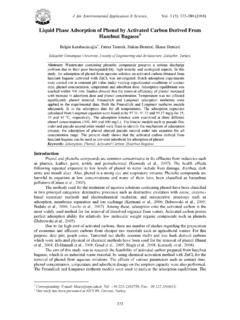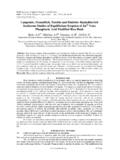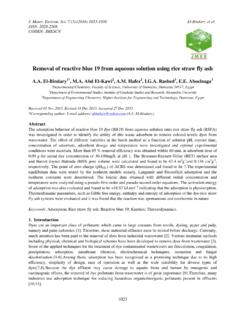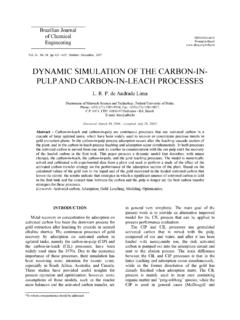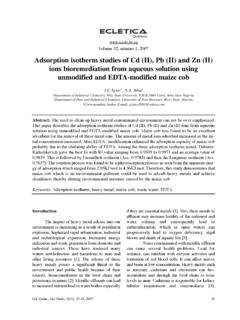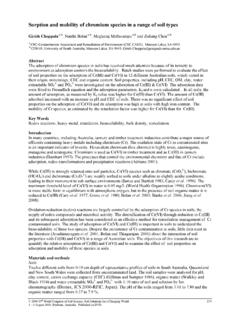Transcription of ELIMINATION OF DIRECT AZO DYE RED 80 IN …
1 ISSN: 2277-9655 [Alahiane* et al., 6(1): January, 2017] Impact Factor: IC Value: CODEN: IJESS7 http: // International Journal of Engineering Sciences & Research Technology [303] IJESRT INTERNATIONAL JOURNAL OF ENGINEERING SCIENCES & RESEARCH TECHNOLOGY ELIMINATION OF DIRECT AZO DYE RED 80 IN AQUEOUS SOLUTION BY HETEROGENEOUS PHOTOCATALYSIS Said Alahiane*, Asma Sennaoui, Samir Qourzal, Fatima Sakr, Ali Assabbane * Laboratory of Electrochemistry, Catalysis and Environment, Catalysis and Environment Team, Department of Chemistry, Faculty of Science, Ibn Zohr University, 8106 CityDakhla, Agadir, Marocco DOI: ABSTRACT The photoelimination, at ambient temperature, of aqueous solutions of DIRECT Red 80 dye (DR 80) in the presence of TiO2 and ZnO catalystshas been studied in the presence of UV radiation generated by an artificial light have determined the influence of several physico-chemical parameters (the mass of the catalyst, the initial concentration of dye and the initial pH of the solution) which govern the kinetics of degradation of this pollutant in order to be in optimum catalysts used show a good photocatalytic activity.
2 Indeed, for the first 15 minutes of irradiation, approximately 96% and 87% of the dye is eliminated in the presence respectively of TiO2 and ZnO. The kinetics of photocatalytic degradation were investigated and modeled by the Langmuir-Hinshelwood equation, by which the k rate constant and the KLH adsorption equilibrium constant were results showed that the pH significantly affects the process of the ELIMINATION of the dye. The maximum rate of degradation of DR 80 is observed at pH = 3 KEYWORDS: Water treatment, DR 80 dye, Heterogeneous photocatalysis, TiO2, ZnO. INTRODUCTION Various industrial sectors such as the textile, paper, rubber, the food and pharmaceutical industries use dyes in the manufacture of their products [1]. The textile industry is one of the largest producers of liquid effluents, which contain dyes that does not bind on the fiber during the dyeing process [2]. These dyes can pollute water plans and change the biological cycles, by affecting the process of photosynthesis.
3 In addition, they can also threaten human health during a prolonged contact with these products which can lead to toxic reactions such as skin allergy (dermatitis) and also affect the respiratory tract functions [3-5]. The most used classification of dyes is that of azo type. This large class includes the DIRECT Red 80 dye (DR 80). It is generally characterized by the presence of one or more azo group (-N=N-) and aromatic nuclei, which are considered as toxic and mutagenic to living organisms [6]. These toxic products are generally very poorly biodegradable. The Advanced Oxidation Processes (AOPs) are techniques that allow their total mineralization (transformation into water, carbon dioxide and / or inorganic ions) [7-10]. Among these AOPs, the heterogeneous photocatalysisis revealed as a potential solution and emerging for the ELIMINATION of these compounds [11-14]. The work presented has for objective the study of the degradation by heterogeneous photocatalysis of diazo dye DR 80, using two semi-conductors TiO2 and ZnO.
4 Thus, the influence of a certain physico-chemical parameters such that the amount of catalyst, the initial concentration of dye and the pH of reaction medium on the adsorption capacity and on the ELIMINATION kinetics of the dye has been examined. MATERIALS AND METHODS Reagent The DR 80 dye (Figure 1) chosen in this study comes from the company Aldrich. It is used without any prior purification in distilled water. Its physico-chemical properties are shown in Table 1. The two carriers used in this ISSN: 2277-9655 [Alahiane* et al., 6(1): January, 2017] Impact Factor: IC Value: CODEN: IJESS7 http: // International Journal of Engineering Sciences & Research Technology [304] study are TiO2 (P-25 : 80% anatase and 20% rutile) and ZnOwhich were provided respectively by the companies Degussa and Sigma Aldrich. The properties of thesephotocatalysts are listed in Table 2. Figure 1 : Chemical structure of DR 80 dye. Table 1 : Physico-chemical properties of the dye DR 80.
5 Type max (nm) Molar mass(g/mol) Solubility in water (g/l) 25 C Famille Chemical formula Anionic 527 1470 60 DIRECT dye C45H26O21N10S6Na6 Table 2 : Main properties of TiO2 and ZnOphotocatalysts. Properties TiO2 ZnO Density (g/cm3) Specific surface (m2/g) EnergyEg (eV) max (nm) pHpcz 3,85 50 3,2 390 6,8 5,6 100 3,2 365 8,9 Photoreactor Experimental studies of the photocatalytic ELIMINATION of the DR 80 dye are performed in a reactor with a half-liter. The latter, is a photochemical reactor to immersion of cylindrical shape in Pyrex, which presents two side openings, one for introducing the oxygen and a second which serves to take samples. These dimensions are of the order 8 and 12 cm, respectively for the diameter and height (Figure 2). During the experiment, the mixture is maintained under continuous agitation (500 rpm) using a magnetic stirrer. Irradiation is performed by means of a mercury vapor lamp high pressure of 125 Watt (HPK-125 W Philips). The lamp is placed in a jacket of cm in diameter and permanently cooled by a continuous flow of water.
6 Figure 2 : Photography of photoreactor used. RESULTS AND DISCUSSION Kinetic study of the adsorption of DR 80 on TiO2 and ZnO Adsorption Kinetics ISSN: 2277-9655 [Alahiane* et al., 6(1): January, 2017] Impact Factor: IC Value: CODEN: IJESS7 http: // International Journal of Engineering Sciences & Research Technology [305] During the photocatalytic degradation, it is necessary to study the phenomenon of adsorption before the irradiation because this is a crucial step before the irradiation. The adsorption kinetics of DR 80 on the two carriers TiO2 and ZnO was realized in the initial pH of the solution at different initial concentrations of dye, with masses of 100 mg/L and 200 mg/L, respectively, for TiO2 and ZnO. Figures 3 and 4 illustrate the adsorption kinetics of the dye on TiO2 and ZnO, and show that it is fast at the beginning of the process and becomes more and more slow during the time of agitation to achieve a level of balance to 30 min on the two catalysts.
7 This time indicates that the adsorption equilibrium is reached. It is therefore imperative to leave the agitation of the mixture at least during this time before the irradiation of the mixture. According to several authors [15, 16], the adsorption may be controlled by the step of transfer of the adsorbate through the external liquid film and /or the diffusion of the solute to the inside of the adsorbent particle. Figure 3 : Kinetics of adsorption of DR80 on ZnO at different initial concentration. Figure 4 : Kinetics of adsorption of DR80 on ZnO at different initial concentration. 0102030405002468101214 Qads ( )Time (min) 40 mg/L 30 mg/L 25 mg/L 20 mg/L 15 mg/L 10 mg/L010203040500510152025303540 Qads ( )Time (min) 30 mg/L 25 mg/L 20 mg/L 15 mg/L 10 mg/L ISSN: 2277-9655 [Alahiane* et al., 6(1): January, 2017] Impact Factor: IC Value: CODEN: IJESS7 http: // International Journal of Engineering Sciences & Research Technology [306] Adsorption isotherms In order to determine the maximum capacity of adsorption of the dye on TiO2 and on ZnO, we adopted the two models more common Langmuir and Freundlich for modeling the experimental values obtained in these phenomena of adsorption.
8 These two adsorption isotherms represent the assessment of the amount adsorbed, depending of the equilibrium concentrations Qe = f(Ce) at a constant temperature (Figure 5). These representations of Langmuir and Freundlich were used to show the distribution of the DR 80 between the solid and liquid phases (the adsorbent and the solution) in equilibrium conditions. Figure 5 : Adsorption isotherm of the dye DR 80 on TiO2 and ZnO. The linear form of the Langmuir isotherm is given by the following equation: = + (Eq 1) Where Qe ( ) is the amount adsorbed at equilibrium, Ce ( ) is the concentration at equilibrium, Qmax ( ) is the maximum amount adsorbed and KL ( ) is adsorption equilibrium constant of Langmuir. Two straight lines are obtained there drawing 1/Qe in function of 1/Ce in the concentration range by dye ranging from 5 to 30 for TiO2 and ZnO (Figure 6). The numerical values of Qmax and KL calculated, respectively, from the intersection with the intercept and slope of the right to TiO2 and ZnO, are represented on the Table 3.
9 We note that the capacities of adsorption of DR 80 on the TiO2 are more important in relation to the one on ZnO. This difference is due to the nature of TiO2 and ZnO and also to the size of the each bracket with the molecule DR 80. 0510152025300510152025303540 Qe ( )Ce ( ) TiO2 ZnO ISSN: 2277-9655 [Alahiane* et al., 6(1): January, 2017] Impact Factor: IC Value: CODEN: IJESS7 http: // International Journal of Engineering Sciences & Research Technology [307] Figure 6 : Linear transformation of the Langmuir model on TiO2 and ZnO. The adsorption results were also modeled by applying the Freundlichmodel, which has as linear transformation the following equation: lnQe= lnKF +1nFlnCe (Eq 2) The graphic representation of lnQe in function of lnCe for the two catalysts studied (TiO2 and ZnO) gives a straight line (Figure 7). The kinetic parameters of adsorption of this model are grouped in the Table 3. A value of 1/nF between 0 and 1 indicates a favorable adsorption [17].
10 According to our results, it appears that the adsorption of the dye DR 80 on the two catalysts is favorable. This table shows a linear correlation coefficient of R2 of Freundlich better than that of Langmuir (ZnO) thus reinforcing the hypothesis of the model Freundlich and highlighting of heterogeneous sites of adsorption. As well, the Langmuir model presents a correlation coefficient R2 better than that of the Freundlich model for the catalyst TiO2, this indicates that the Langmuir isotherm better describes the adsorption than that of Freundlich and highlighting a single type of adsorption sites. Figure 7 : Linear transformation of the Freundlich model on TiO2 and ZnO. 0,000,050,100,150,200,250,020,040,060,08 0,100,120,14y = 5028x + 0,0747 R2 = 0,9295y = 0,0481x + 0,025 R2 = 0,9760 1/Qe1/Ce TiO2 ZnO0,00,51,01,52,02,53,03,50,00,51,01,52 ,02,53,03,54,0y = 0,3732x + 1,1923 R2 = 0,9649y = 0,1747x + 3,0846 R2 = 0,9657 LnQeLnCe TiO2 ZnO ISSN: 2277-9655 [Alahiane* et al.]
